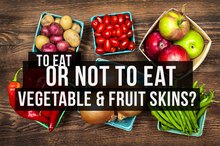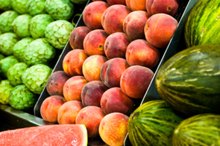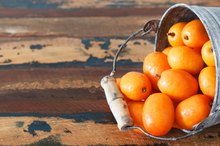Organic Oranges Vs. Commercial Oranges
Organic oranges and commercial oranges might look the same, but they do have some big differences. The first you might note is the price, with organic oranges priced higher than their non-organic counterparts. You can determine if the higher price is worth it by realizing what it takes to produce an organic orange juxtaposed against the potentially high cost of commercial oranges on the environment.
Growing
Organic oranges grow on certified organic orchards which use no growth hormones or chemicals. Rather than chemical pesticides, organic growers rely on beneficial birds and insects to control pests and disease. They use natural compost and manure as fertilizer instead of chemicals to encourage growth and never use chemical herbicides or fungicides.
- Organic oranges grow on certified organic orchards which use no growth hormones or chemicals.
- They use natural compost and manure as fertilizer instead of chemicals to encourage growth and never use chemical herbicides or fungicides.
Eating
How to Ripen Oranges in the Microwave
Learn More
Although commercial oranges are exposed to a wide range of chemicals, the chemicals don’t reach the inside of the orange. The peel acts as a natural barrier and, as long as you don’t eat the peel or use it in recipes, you won’t ingest the chemicals that coat the outside of the orange. Organic oranges have the same nutritional values and calories as commercial oranges 1. A small orange contains 45 calories, 1 gram of protein, 11 grams of carbohydrates, 2 grams of fiber and 9 grams of sugar. It is also loaded with vitamins and minerals, particularly calcium, potassium and vitamins C and A.
- Although commercial oranges are exposed to a wide range of chemicals, the chemicals don’t reach the inside of the orange.
Environment
Pesticides may not reach the meat of the orange and affect your personal health, but they do leak into the environment. Princeton University reports only one percent of chemical pesticides actually targets the pests for which they are intended, while the other 99 percent makes its merry way into the environment. Chemical contamination from pesticides, herbicides and fertilizers affects groundwater, soil and wildlife.
Certification
Organic Beef Vs. Traditional Beef
Learn More
Proof of organic certification is often noted by the presence of a green and white USDA Organic sticker. The organic sticker means the oranges have met the strict standards overseeing the growth, harvesting and handling of the fruit. Organic stickers, however, are voluntary, although many growers choose to use them. Other terms, such as “naturally grown,” are not synonymous with organic and don’t mean much since they have no regulations to meet.
- Proof of organic certification is often noted by the presence of a green and white USDA Organic sticker.
- The organic sticker means the oranges have met the strict standards overseeing the growth, harvesting and handling of the fruit.
Related Articles
References
- USDA National Nutrient Database: Oranges
- Anwar S, Ahmed N, Speciale A, Cimino F, Saija A. Bitter Orange (Citrus Aurantium L.) Oils. InEssential Oils in Food Preservation, Flavor and Safety. Academic Press. 2016; 259-268.
- Uwague A. Phytochemical Screening and Proximate Analysis of Sweet Orange (Citrus Sinesis) Fruit Wastes. International Journal of Scientific Research in Science and Technology. 2017; 3(7).
- Orange, raw. FoodData Central. U.S Department of Agriculture. Published April 1, 2019.
- Agricultural Research Service. Oranges, raw. U.S. Department of Agriculture. 2019.
- Cleveland Clinic. Improving Your Health With Fiber. 2019.
- Harvard Health Publishing. Glycemic index for 60+ foods. Harvard Medical School. 2020.
- Centers for Disease Control and Prevention. How to Use Fruits and Vegetables to Help Manage Your Weight. 2020.
- UCSF Health. Cholesterol Content of Foods. University of California San Fransisco. 2020.
- Health Essentials. 3 Vitamins That Are Best for Boosting Your Immunity. Cleveland Clinic. 2020.
- Agriculture Research Service. Banana, raw. U.S. Department of Agriculture. 2019.
- Kaczmarczyk MM, Miller MJ, Freund GG. The health benefits of dietary fiber: beyond the usual suspects of type 2 diabetes mellitus, cardiovascular disease and colon cancer. Metabolism. 2012 Aug 1;61(8):1058-66. doi:10.1016/j.metabol.2012.01.017
- Gupta C, Prakash D. Phytonutrients as therapeutic agents. Journal of Complementary and Integrative Medicine. 2014 Sep 1;11(3):151-69. doi:10.1515/jcim-2013-0021
- National Institutes of Health Office of Dietary Supplements. Vitamin C: Fact sheet for consumers. 2019.
- American Heart Association. How potassium can help control high blood pressure. 2016.
- Juraschek SP, Guallar E, Appel LJ, Miller ER. Effects of vitamin C supplementation on blood pressure: A meta-analysis of randomized controlled trials. Am J Clin Nutr. 2012;95(5):1079-88. doi:10.3945/ajcn.111.027995
- National Institutes of Health. Office of Dietary Supplements. Thiamin: Fact Sheet for Health Professionals. 2019.
- Weikel KA, Garber C, Baburins A, Taylor A. Nutritional modulation of cataract. Nutr Rev. 2014;72(1):30-47. doi:10.1111/nure.12077
- Imbard A, Benoist JF, Blom HJ. Neural tube defects, folic acid and methylation. International journal of environmental research and public health. 2013 Sep;10(9):4352-89. doi:10.3390/ijerph10094352
- Iorio RA, Del Duca S, Calamelli E, Pula C, Lodolini M, Scamardella F, Pession A, Ricci G. Citrus allergy from pollen to clinical symptoms. PLoS One. 2013;8(1):e53680. doi:10.1371/journal.pone.0053680
- Hankinson A, Lloyd B, Alweis R. Lime-induced phytophotodermatitis. J Community Hosp Intern Med Perspect. 2014;4(4). doi:10.3402/jchimp.v4.25090
- Bailey DG, Dresser G, Arnold JM. Grapefruit–medication interactions: Forbidden fruit or avoidable consequences?. Cmaj. 2013 Mar 5;185(4):309-16. doi:10.1503/cmaj.120951
- Agriculture and Natural Resources. Oranges. University of California.
- Sir Elkhatim KA, Elagib RAA, Hassan AB. Content of phenolic compounds and vitamin C and antioxidant activity in wasted parts of Sudanese citrus fruits. Food Sci Nutr. 2018 May 8;6(5):1214-1219. doi:10.1002/fsn3.660
- UC Davis Health. Is Fruit Juice Bad for You and Your Children?
Writer Bio
Ryn Gargulinski is a writer, artist and performer whose journalism career began in 1991. Credits include two illustrated books, "Bony Yoga" and "Rats Incredible." She holds a Master of Arts in English literature and folklore and a Bachelor of Fine Arts in creative writing with a French minor from Brooklyn College.









